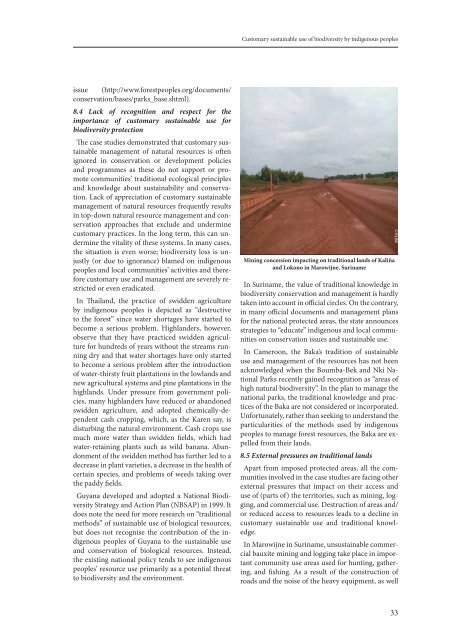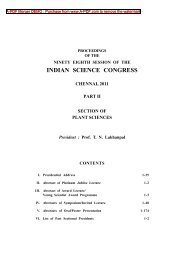sustainable use of biological diversity.pdf - India Environment Portal
sustainable use of biological diversity.pdf - India Environment Portal
sustainable use of biological diversity.pdf - India Environment Portal
Create successful ePaper yourself
Turn your PDF publications into a flip-book with our unique Google optimized e-Paper software.
Customary <strong>sustainable</strong> <strong>use</strong> <strong>of</strong> bio<strong>diversity</strong> by indigenous peoples<br />
issue (http://www.forestpeoples.org/documents/<br />
conservation/bases/parks_base.shtml).<br />
8.4 Lack <strong>of</strong> recognition and respect for the<br />
importance <strong>of</strong> customary <strong>sustainable</strong> <strong>use</strong> for<br />
bio<strong>diversity</strong> protection<br />
The case studies demonstrated that customary <strong>sustainable</strong><br />
management <strong>of</strong> natural resources is <strong>of</strong>ten<br />
ignored in conservation or development policies<br />
and programmes as these do not support or promote<br />
communities’ traditional ecological principles<br />
and knowledge about sustainability and conservation.<br />
Lack <strong>of</strong> appreciation <strong>of</strong> customary <strong>sustainable</strong><br />
management <strong>of</strong> natural resources frequently results<br />
in top-down natural resource management and conservation<br />
approaches that exclude and undermine<br />
customary practices. In the long term, this can undermine<br />
the vitality <strong>of</strong> these systems. In many cases,<br />
the situation is even worse; bio<strong>diversity</strong> loss is unjustly<br />
(or due to ignorance) blamed on indigenous<br />
peoples and local communities’ activities and therefore<br />
customary <strong>use</strong> and management are severely restricted<br />
or even eradicated.<br />
In Thailand, the practice <strong>of</strong> swidden agriculture<br />
by indigenous peoples is depicted as “destructive<br />
to the forest” since water shortages have started to<br />
become a serious problem. Highlanders, however,<br />
observe that they have practiced swidden agriculture<br />
for hundreds <strong>of</strong> years without the streams running<br />
dry and that water shortages have only started<br />
to become a serious problem after the introduction<br />
<strong>of</strong> water-thirsty fruit plantations in the lowlands and<br />
new agricultural systems and pine plantations in the<br />
highlands. Under pressure from government policies,<br />
many highlanders have reduced or abandoned<br />
swidden agriculture, and adopted chemically-dependent<br />
cash cropping, which, as the Karen say, is<br />
disturbing the natural environment. Cash crops <strong>use</strong><br />
much more water than swidden fields, which had<br />
water-retaining plants such as wild banana. Abandonment<br />
<strong>of</strong> the swidden method has further led to a<br />
decrease in plant varieties, a decrease in the health <strong>of</strong><br />
certain species, and problems <strong>of</strong> weeds taking over<br />
the paddy fields.<br />
Guyana developed and adopted a National Bio<strong>diversity</strong><br />
Strategy and Action Plan (NBSAP) in 1999. It<br />
does note the need for more research on “traditional<br />
methods” <strong>of</strong> <strong>sustainable</strong> <strong>use</strong> <strong>of</strong> <strong>biological</strong> resources,<br />
but does not recognise the contribution <strong>of</strong> the indigenous<br />
peoples <strong>of</strong> Guyana to the <strong>sustainable</strong> <strong>use</strong><br />
and conservation <strong>of</strong> <strong>biological</strong> resources. Instead,<br />
the existing national policy tends to see indigenous<br />
peoples’ resource <strong>use</strong> primarily as a potential threat<br />
to bio<strong>diversity</strong> and the environment.<br />
Mining concession impacting on traditional lands <strong>of</strong> Kaliña<br />
and lokono in Marowijne, Suriname<br />
In Suriname, the value <strong>of</strong> traditional knowledge in<br />
bio<strong>diversity</strong> conservation and management is hardly<br />
taken into account in <strong>of</strong>ficial circles. On the contrary,<br />
in many <strong>of</strong>ficial documents and management plans<br />
for the national protected areas, the state announces<br />
strategies to “educate” indigenous and local communities<br />
on conservation issues and <strong>sustainable</strong> <strong>use</strong>.<br />
In Cameroon, the Baka’s tradition <strong>of</strong> <strong>sustainable</strong><br />
<strong>use</strong> and management <strong>of</strong> the resources has not been<br />
acknowledged when the Boumba-Bek and Nki National<br />
Parks recently gained recognition as “areas <strong>of</strong><br />
high natural bio<strong>diversity</strong>”. In the plan to manage the<br />
national parks, the traditional knowledge and practices<br />
<strong>of</strong> the Baka are not considered or incorporated.<br />
Unfortunately, rather than seeking to understand the<br />
particularities <strong>of</strong> the methods <strong>use</strong>d by indigenous<br />
peoples to manage forest resources, the Baka are expelled<br />
from their lands.<br />
8.5 External pressures on traditional lands<br />
Apart from imposed protected areas, all the communities<br />
involved in the case studies are facing other<br />
external pressures that impact on their access and<br />
<strong>use</strong> <strong>of</strong> (parts <strong>of</strong>) the territories, such as mining, logging,<br />
and commercial <strong>use</strong>. Destruction <strong>of</strong> areas and/<br />
or reduced access to resources leads to a decline in<br />
customary <strong>sustainable</strong> <strong>use</strong> and traditional knowledge.<br />
In Marowijne in Suriname, un<strong>sustainable</strong> commercial<br />
bauxite mining and logging take place in important<br />
community <strong>use</strong> areas <strong>use</strong>d for hunting, gathering,<br />
and fishing. As a result <strong>of</strong> the construction <strong>of</strong><br />
roads and the noise <strong>of</strong> the heavy equipment, as well<br />
© KLIM<br />
33
















